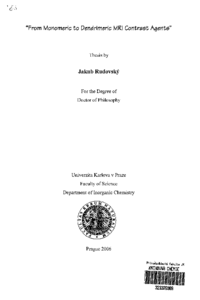From Monomeric to Dendrimeric MRI Contrast Agents
From Monomeric to Dendrimeric MRI Contrast Agents
dissertation thesis (DEFENDED)

Reason for restricted acccess:
The document is accessible only in the physical database of theses.
View/
Permanent link
http://hdl.handle.net/20.500.11956/95746Identifiers
Study Information System: 198863
CU Caralogue: 990021793950106986
Collections
- Kvalifikační práce [20861]
Author
Advisor
Referee
Botta, Mauro
Peters, Joop
Faculty / Institute
Faculty of Science
Discipline
Anorganická chemie
Department
Department of Inorganic Chemistry
Date of defense
26. 6. 2006
Publisher
Univerzita Karlova, Přírodovědecká fakultaLanguage
Czech
Grade
Pass
4, Conclueione To conclude, in my Thesis I found that ligands with phosphorus acid ped- a]11 alm substituting carboxylate in DOTA structure are endowéd with several Íavor- able features like a water residence liťetime optimal for a preparation of high- relaxivity covalent conjugates' Importantly, these promising p'óp.'ti.. were proved to persist even after the conjugation as was demonstrated ón u iy.."t.ical áitopic model compound for the first time. Imporlantly, the folrowing study of row- ge.nelatlon PAMAM conjugate proved that, unlike most oťthe published studies, trre rela:livity of these macromolecular systems ísnot exchang.-li.it"d. This has al. lowed meto investigate in detaíl the limiting effects on the iela;rivity of the internal ro^tation of the complex in the conjugates. In addition' I shown that tňe local mottons ofthe dendrimer backbone and ofthe conjugated complexes can be slowed down by a- formatíon of supramolecular adducts with cationic polyaminoacids. Also, I was able to quantitatively evaluate the effects of the local motíons and to effectively reduce them. As a result, the efficacy of these systems as relaxation agents is the highest so far reported for this class of compounds that can find a varieň of poten- tial biomedical/bioinorganic applications. For the close future, we plan in...
4, Conclueione To conclude, in my Thesis I found that ligands with phosphorus acid ped- a]11 alm substituting carboxylate in DOTA structure are endowéd with several Íavor- able features like a water residence liťetime optimal for a preparation of high- relaxivity covalent conjugates' Importantly, these promising p'óp.'ti.. were proved to persist even after the conjugation as was demonstrated ón u iy.."t.ical áitopic model compound for the first time. Imporlantly, the folrowing study of row- ge.nelatlon PAMAM conjugate proved that, unlike most oťthe published studies, trre rela:livity of these macromolecular systems ísnot exchang.-li.it"d. This has al. lowed meto investigate in detaíl the limiting effects on the iela;rivity of the internal ro^tation of the complex in the conjugates. In addition' I shown that tňe local mottons ofthe dendrimer backbone and ofthe conjugated complexes can be slowed down by a- formatíon of supramolecular adducts with cationic polyaminoacids. Also, I was able to quantitatively evaluate the effects of the local motíons and to effectively reduce them. As a result, the efficacy of these systems as relaxation agents is the highest so far reported for this class of compounds that can find a varieň of poten- tial biomedical/bioinorganic applications. For the close future, we plan in...
